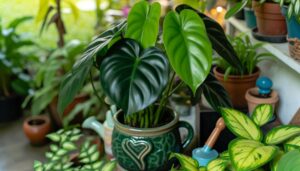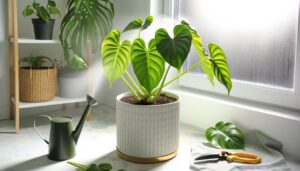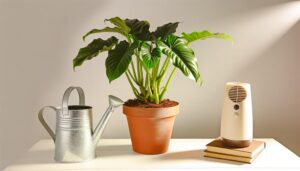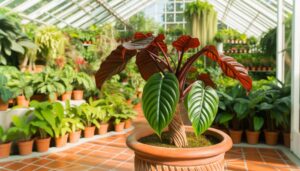Monstera Philodendron Care: Essential Guidelines!
Monstera Philodendron, including the popular ‘Swiss cheese plant‘, thrives in conditions mirroring its tropical habitat. Best growth requires high humidity (50-70%), warm temperatures ranging from 65-80°F (18-27°C), and a location in bright, indirect light.
Regular, regulated watering when the top inch of soil is dry is essential, as is a balanced fertilizer during growth season to provide necessary nutrients. Good drainage, stringent inspections, and disease prevention strategies further promote healthy growth.
Acquiring the skills to perceive and promptly resolve common issues, such as yellow leaves and slowed growth, greatly enhances successful Monstera care. Explore further for more in-depth insights.
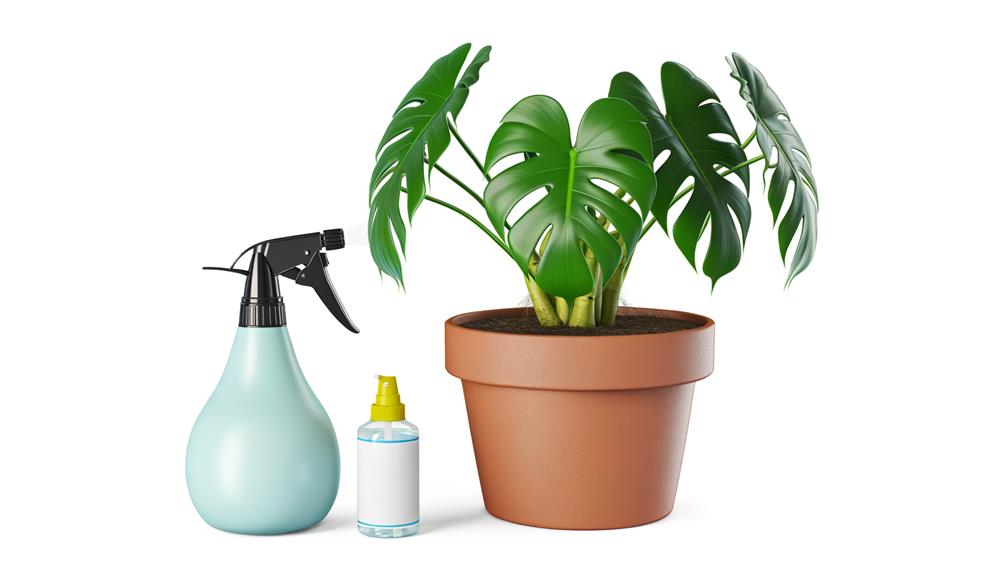
Key Takeaways
- Monstera Philodendron requires bright, indirect light and stable temperatures between 65-85°F (18-29°C).
- The plant thrives in high humidity levels of 50-70% and needs watering when the top inch of soil is dry.
- Fertilizing using a diluted solution during the growth season contributes to its health and vitality.
- Regular inspections and maintenance of proper humidity help prevent common plant diseases like leaf spot and root rot.
- Propagation is feasible through methods like stem cuttings, air layering, division, leaf bud cuttings, or seed sowing.
Understanding Monstera Philodendron
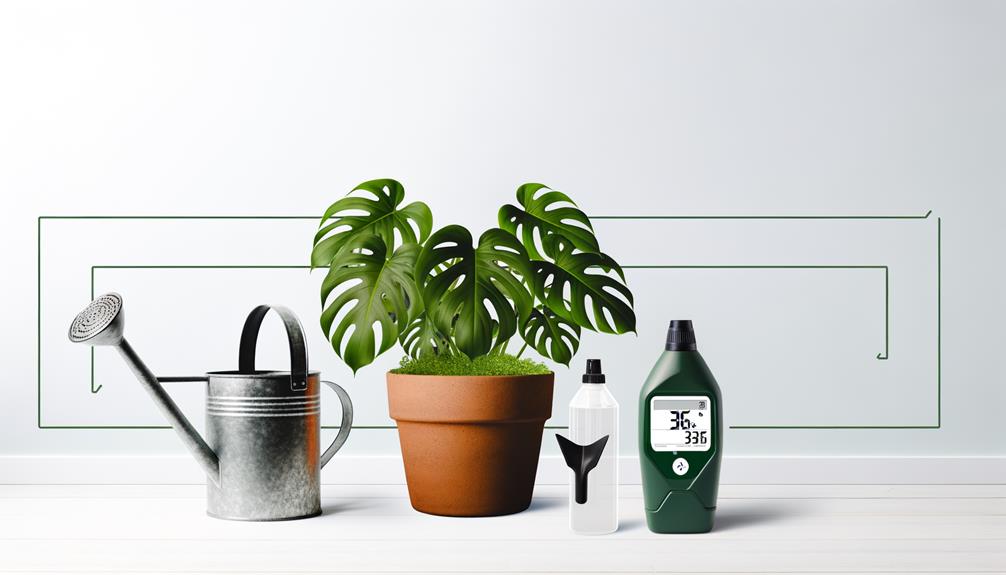
In the field of botanical science, Monstera Philodendron is a unique genus of tropical plants renowned for their distinctive, perforated leaves and robust growth patterns. Native to the tropical regions of the Americas, this genus includes a variety of species, each characterized by its unique leaf shape and size.
The most well-known among them is Monstera deliciosa, often referred to as the ‘Swiss cheese plant.’ The perforations or fenestrations on its leaves increase in number and size as the plant matures. These adaptations give the plant an increased surface area, allowing it to capture more sunlight in its natural, dimly lit habitat.
Understanding the plant’s natural growth habits forms a pivotal foundation for its successful cultivation.
Ideal Growing Conditions
To nurture peak development and vitality in Monstera Philodendron, one must replicate the plant’s original, tropical habitat characterized by high humidity, warm temperatures, and indirect, filtered sunlight. Specifically, temperatures between 65-80°F (18-27°C) are most favorable for growth. Lower temperatures can slow development and lead to leaf damage.
High humidity is essential, mirroring the plant’s natural rainforest environment. A humidity level of 50-70% is recommended. For sunlight, this species flourishes in bright, indirect light. Direct sunlight can cause leaf burn, while insufficient light can impede growth. To achieve this, place the plant near a north or east-facing window.
Providing these ideal conditions will guarantee your Monstera Philodendron thrives, standing as proof of your attentive care.
Watering Your Monstera
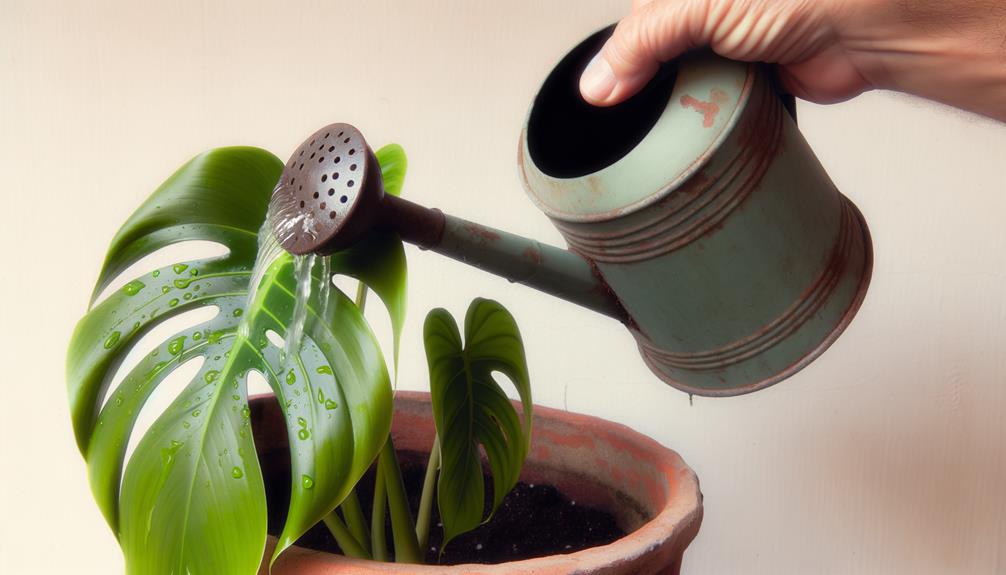
Understanding the watering needs of your Monstera Philodendron is vital for its overall health and growth, as this tropical plant prefers a consistent, yet carefully regulated moisture level.
Watering should be done once the top inch of soil has dried out, usually every 1-2 weeks. Overwatering can lead to root rot, a detrimental condition that can cause the plant to wilt and die. Conversely, under-watering can cause the leaves to turn yellow and drop.
A measured approach is essential, ensuring the plant benefits from its natural propensity for humid environments, without saturating the root system. Utilizing a moisture meter can be a beneficial tool to maintain the best hydration.
Lighting and Temperature Needs
Monstera Philodendron’s lighting and temperature requirements play an equally important role in its growth and health as its watering needs do.
This tropical plant thrives best in bright, indirect light environments. Direct sunlight can harm its foliage, causing yellowing or scorching. Placing it near a north or east-facing window is beneficial. Artificial light sources, such as fluorescent lights, can also suffice in low-light situations.
Regarding temperature, Monstera prefers a stable, warm climate typical of its native tropical habitat. Best temperatures range between 65-85°F (18-29°C), with a relative humidity of around 60%.
Sudden temperature drops or cold drafts can damage the plant, stressing it and potentially leading to leaf drop. By understanding and respecting these parameters, you can ensure your Monstera’s well-being.
Nourishing With Fertilizer

To guarantee the thriving growth and radiant health of your Monstera Philodendron, proper nutrition via appropriate fertilization is paramount.
This involves selecting the right fertilizer that meets the nutrient demands of this specific plant species, mastering the techniques for its successful application, and closely monitoring its effects on plant development.
In this section, we will thoroughly explore these critical aspects that contribute to optimizing the benefits of fertilizer in Monstera Philodendron care.
Choosing the Right Fertilizer
Choosing the right fertilizer for your Monstera Philodendron is an essential step in ensuring its healthy growth and development. You must consider the plant’s specific nutritional needs, which include macronutrients like nitrogen (N), phosphorus (P), and potassium (K), and micronutrients such as iron, manganese, and zinc.
Here’s a table to guide you:
| Fertilizer Type | Macronutrients | Micronutrients |
|---|---|---|
| Organic Compost | High in N, P, K | Varied |
| Synthetic Blend | Balanced N, P, K | Few |
| Slow-Release | Low in N, P, K | Few |
| Liquid Feed | High in N, P, K | Many |
| Specialty Blend | Balanced N, P, K | Many |
Fertilizer Application Techniques
After selecting the appropriate fertilizer to meet the nutritional needs of your Monstera Philodendron, the next step involves understanding and implementing the correct application techniques.
Concentration, timing, and method of application are critical components of this process. Fertilizer should be diluted to half the manufacturer’s recommended strength to prevent root burn.
The most suitable time to fertilize is during the growth season (spring and summer) when the plant is actively absorbing nutrients.
As for the method, apply the fertilizer evenly around the base of the plant, ensuring it reaches the roots. Avoid direct contact with the plant’s leaves to prevent leaf burn.
Monitoring Fertilizer Effects
Observing the effects of your fertilizer application on the Monstera Philodendron is an essential step in promoting its optimal growth and overall health. Careful monitoring allows early detection of nutrient deficiencies or toxic excesses that can lead to symptoms such as leaf yellowing, browning, or stunted growth.
Regular evaluation of the plant’s physical condition, including leaf color, texture, and size, provides a reliable indication of the nutrient uptake. Additionally, monitor the soil’s pH level regularly, as an inappropriate pH can impede nutrient absorption. Use a reliable soil pH tester for accuracy.
Lastly, keep in mind that over-fertilization can result in salt accumulation, which may cause root burn. Thus, ensure proper watering practices to flush out excess salts.
Pruning and Repotting
In order to maintain peak health and growth for your Monstera Philodendron, regular pruning and periodic repotting become essential elements of its care regimen. Pruning, done ideally in spring or early summer, removes dead or yellow leaves, promoting healthier foliage. Repotting should occur every 2-3 years, using well-drained soil in a pot slightly larger than the last.
Here’s a handy table to guide your care efforts:
| Task | Ideal Time |
|---|---|
| Pruning | Spring / Early Summer |
| Repotting | Every 2-3 Years |
Disease and Pest Prevention
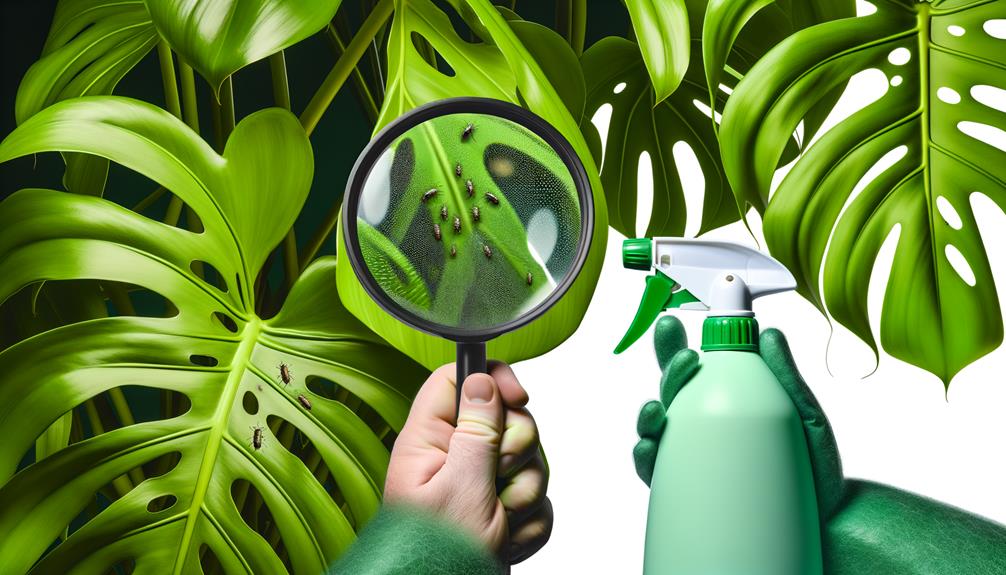
Ensuring the health of your Monstera Philodendron involves not only proper maintenance but also effective disease and pest prevention strategies.
Key to this is the early identification of common pests and understanding the signs of potential plant diseases.
In the following sections, we will explore these aspects in detail, focusing on preventative measures and suitable interventions.
Identifying Common Pests
While the Monstera Philodendron is generally a hardy plant, it is important to identify and address common pests to maintain its health and vigor. Mealybugs are soft-bodied insects covered in a white waxy substance, often found nestled in leaf axils. They excrete honeydew, promoting sooty mold growth.
Scale insects encase themselves in bumps that attach to plant stems and leaf undersides, causing yellowing and wilting. Spider mites, tiny arachnids visible as fine webbing on the plant, can cause foliage to turn yellow and drop off.
Regularly inspect your Monstera Philodendron for these pests and treat promptly to uphold sustained plant health.
Preventing Plant Diseases
To sustain your Monstera Philodendron in prime condition, preventing plant diseases is as crucial as eliminating pests, with a keen focus on common issues such as leaf spot, root rot, and bacterial wilt.
Regular inspections are essential to detect early signs of disease. Leaf spot, identifiable by yellow or brown spots on leaves, can be avoided by maintaining proper humidity levels and avoiding overhead watering.
Root rot, a fungal disease, can be averted by promoting good drainage and avoiding overwatering. Bacterial wilt, a soil-borne disease, can be controlled by sterilizing potting soil and tools.
Employing these prevention strategies will help your Monstera Philodendron remain healthy, vibrant, and free from debilitating diseases.
Propagation Techniques
The propagation of Monstera Philodendron, a crucial aspect of its care, involves several tried and tested techniques that are both efficient and scientifically proven. These techniques maximize the growth potential of the plant, ensuring its health and longevity.
The following table provides a brief overview of the most common propagation methods:
| Method | Description |
|---|---|
| Stem Cuttings | Cut a stem just below an aerial root node, leave it to callous for a few days, then plant in soil or water |
| Air Layering | Wound a stem and cover it with damp moss, then wrap it in plastic until roots develop |
| Division | Split a mature plant into smaller pieces, each with roots and leaves |
| Leaf Bud Cuttings | Cut a stem with a leaf bud, let it callous, then plant it |
| Seed | Sow seeds in a well-draining medium, keep humid and warm |
Choose the method that best suits your care capacity and the plant’s needs.
Common Monstera Problems and Solutions
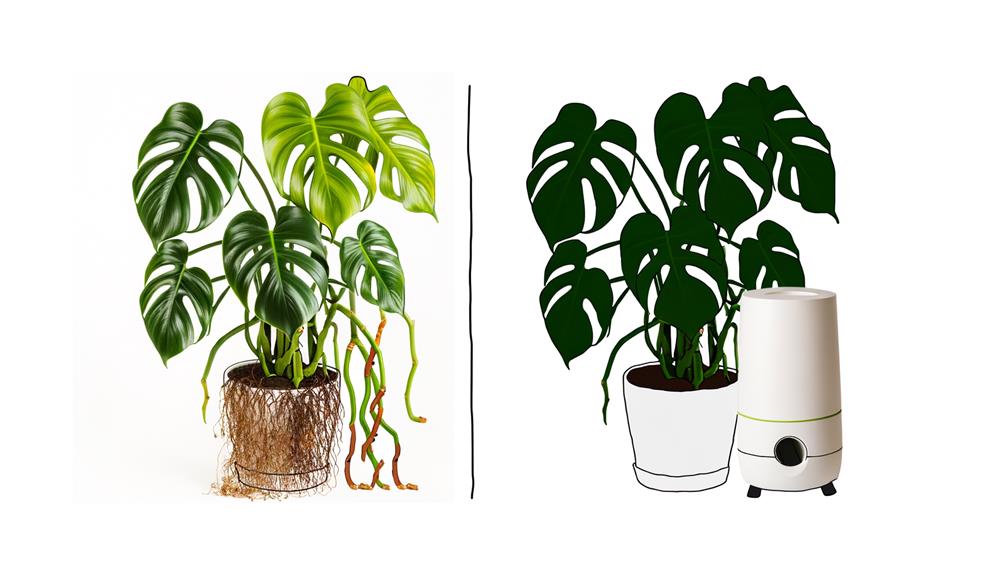
Having reviewed the propagation techniques, it’s now pertinent to explore the common issues that Monstera Philodendron plants often face, along with effective solutions to these problems.
One prevalent issue is yellowing leaves, often due to overwatering. The remedy is to reduce watering frequency, ensuring the top inch of soil is dry before watering again.
Another problem is browning leaf tips, typically resulting from low humidity. To rectify this, mist the plant regularly or use a humidifier to increase moisture levels.
To conclude, a common issue is slow growth, usually due to inadequate light. Place the plant in a spot with bright, indirect light to promote growth.
These scientifically proven solutions will enhance your Monstera Philodendron care, fostering healthier, more vibrant plants.
Monstera Split Leaf Philodendron Care
- Light: Place in bright, indirect sunlight. Avoid direct sun to prevent leaf burn.
- Water: Water when the top inch of soil is dry, approximately every 7-10 days. Ensure the pot has drainage holes to prevent waterlogging.
- Temperature: Maintain temperatures between 65-80°F (18-27°C). Avoid drafts and sudden temperature changes.
- Humidity: Prefers high humidity (60-70%). Use a humidifier, mist the leaves, or place the pot on a tray of wet pebbles.
- Soil: Use well-draining soil, such as a mix of perlite, peat moss, and indoor potting mix.
- Fertilizer: Feed every 2 weeks during the growing season with a balanced, diluted fertilizer.
- Pruning: Remove dead or damaged leaves to promote healthy growth.
- Repotting: Repot every 2-3 years into a slightly larger pot.
By following these care tips, your Monstera Split Leaf Philodendron will thrive and add vibrant greenery to your home.
Conclusion
In summation, the Monstera Philodendron, a tropical beauty, demands careful attention to thrive. By grasping its requirements such as suitable watering, lighting, temperature, and nourishment, one can nurture it successfully.
Routine pruning and repotting promote its growth while proactive pest control safeguards its health. Propagation techniques assist in its multiplication. Addressing common problems promptly guarantees the plant’s longevity.
Hence, the Monstera Philodendron is an exquisite horticultural challenge, a living proof of the adage ‘beauty does not come without effort’.

